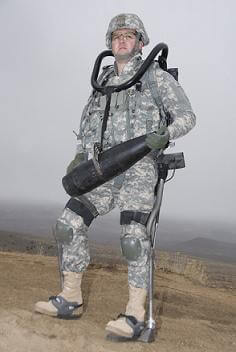Lockheed Martin’s Army Exoskeleton to Get More Power (Video)

Share
The future of the military may be robots, or it may be soldiers dressed up as robots. Global arms manufacturing Lockheed Martin negotiated a deal with Berkeley Bionics and is now actively developing their HULC exoskeleton for the US military. The Human Universal Load Carrier isn't a full body suit, it's designed to ease the stress of walking and allow users to carry weight over long distances without getting tired. The frame of the HULC will bear up to 200 lbs and still allow the user to run at 7 mph with 10 mph bursts. It is also flexible enough to allow squatting, crawling, or kneeing and can be unpacked or packed in about 30 seconds. HULC is an autonomous systems (not powered by cable) but its current Li-ion batteries only give it about 1 hour of run time (less for high-stress work). That's why Lockheed recently announced it would have Protonex develop a 72 hour fuel cell style power supply for the HULC. What could that do for the average soldier in the field? It takes the HULC from an oddity to a fieldable platform. Watch the latest promotional video from Lockheed Martin after the break to give you an idea.
Although the HULC can come with a shoulder attachment to carry objects, it doesn't have arms. That's a major difference between it and the exoskeleton developed by rival Sarcos. Another difference is that the HULC decreases the load on a soldier, but doesn't really augment strength. It's the progeny of hiking and climbing systems. Like the knee exoskeleton we've discussed recently, HULC is really about efficiency. Can a soldier carry 80 lbs on his or her own? Yes. But the HULC will let them do it without getting tired, and by consuming 15% less oxygen. That's an important statistic for soldiers looking to maneuver through mountains in Afghanistan. I think the focus on efficiency is more appropriate in this context than it was with the knee-exoskeleton.
Be Part of the Future
Sign up to receive top stories about groundbreaking technologies and visionary thinkers from SingularityHub.


Still, it's hard for me to believe in any current exoskeleton as a tactical weapon. Lockheed has done a good job highlighting how HULC might work with a soldier in the field, but it's just one more machine that can fail far away from base. I'm glad that Protonex is working towards a 72 hour power supply, because the current 1 hour time limit seems laughable if this tool were to actually be used during missions. Overall, I'm much more inclined to use a Big Dog or other dedicated robotic hauler than to try to adapt soldiers into that role.
I've always seen exoskeletons as better fitted to turn average people into human forklifts. Nurses needing to pick up elderly patients, construction workers trying to lift heavy supplies, or the disabled struggling to move their own bodies. Those are the arenas where exos appear to be well-suited and they are the fields pursued by non-military groups like Cyberdyne and Kobayashi Labs.
Augmenting human soldiers is an interesting possibility. The HULC could be equipped with armor and heavy weapons to turn you into a human-sized tank. But I think that's short-sighted. Drones can carry just as much weaponry, can fly, and don't risk a soldier's life. With a human tele-operating their controls, I think robots make more sense than roboticized humans. Of course, we are talking about war here. Maybe it's not supposed to make sense.
[photo and video credit: Lockheed Martin]
Related Articles

These Robots Are the Size of Single Cells and Cost Just a Penny Apiece

In Wild Experiment, Surgeon Uses Robot to Remove Blood Clot in Brain 4,000 Miles Away

A Squishy New Robotic ‘Eye’ Automatically Focuses Like Our Own
What we’re reading
